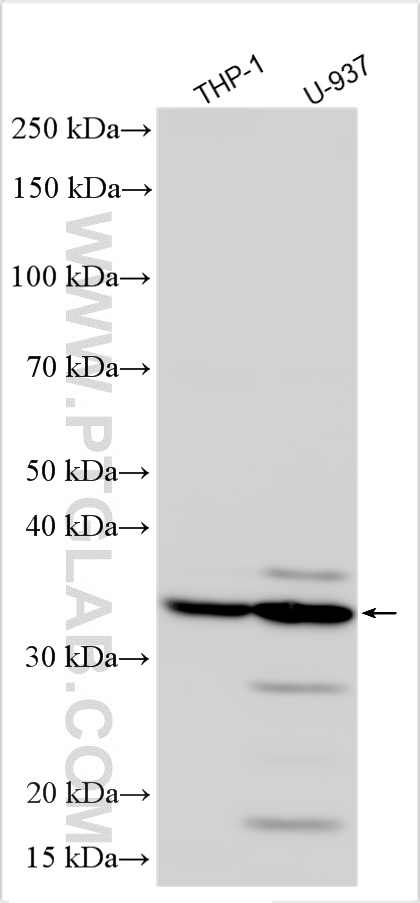验证数据展示
经过测试的应用
| Positive WB detected in | THP-1 cells, U-937 cells |
推荐稀释比
| 应用 | 推荐稀释比 |
|---|---|
| Western Blot (WB) | WB : 1:1000-1:4000 |
| It is recommended that this reagent should be titrated in each testing system to obtain optimal results. | |
| Sample-dependent, Check data in validation data gallery. | |
产品信息
30409-1-AP targets LGALS9/Galectin-9 in WB, ELISA applications and shows reactivity with human samples.
| 经测试应用 | WB, ELISA Application Description |
| 经测试反应性 | human |
| 免疫原 | LGALS9/Galectin-9 fusion protein Eg0084 种属同源性预测 |
| 宿主/亚型 | Rabbit / IgG |
| 抗体类别 | Polyclonal |
| 产品类型 | Antibody |
| 全称 | lectin, galactoside-binding, soluble, 9 |
| 别名 | Galectin 9, LGALS9, Ecalectin, Gal 9, Gal-9 |
| 计算分子量 | 323 aa, 36 kDa |
| 观测分子量 | 35 kDa |
| GenBank蛋白编号 | BC110340 |
| 基因名称 | Galectin-9 |
| Gene ID (NCBI) | 3965 |
| 偶联类型 | Unconjugated |
| 形式 | Liquid |
| 纯化方式 | Antigen affinity purification |
| UNIPROT ID | O00182 |
| 储存缓冲液 | PBS with 0.02% sodium azide and 50% glycerol, pH 7.3. |
| 储存条件 | Store at -20°C. Stable for one year after shipment. Aliquoting is unnecessary for -20oC storage. |
背景介绍
The galectins, formerly known as S-type lectins, are a family of β-galactoside-binding proteins implicated in modulating cell-cell and cell-matrix interactions. Galectin-9 (LGALS9) is a tandem repeat-type member of the galectin family. It has three isoforms (named galectin-9L, galectin-9M, and galectin-9S): long type of 355 amino acids, medium type of 323 amino acids, and short type of 311 amino acids. Galectin-9 is ubiquitously expressed in a variety of tissues, including lymph nodes and spleen, and overexpressed in Hodgkin disease tissue. It is involved in chemoattraction, apoptosis, and the regulation of cell differentiation and has anti-allergic effects. It has been reported that galectin-9 is a ligand for Tim-3, through which galectin-9 can induce T-helper type 1 lymphocyte (Th1) death.
实验方案
| Product Specific Protocols | |
|---|---|
| WB protocol for LGALS9/Galectin-9 antibody 30409-1-AP | Download protocol |
| Standard Protocols | |
|---|---|
| Click here to view our Standard Protocols |
